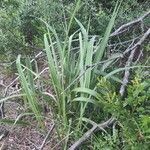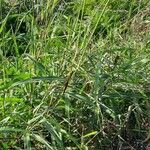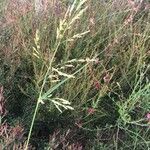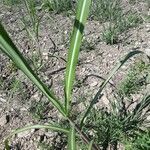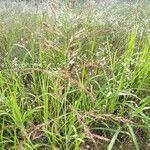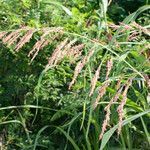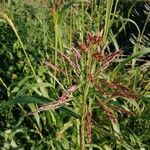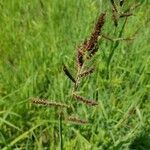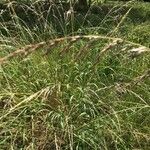Perennial with vigorous spreading rhizomes. Culms 0.5–1.5 m tall, 4–6 mm in diam.; nodes puberulous. Leaf sheaths glabrous; leaf blades linear or linear-lanceolate, 25–80 × 1–4 cm, glabrous; ligule 0.5–1 mm, glabrous. Panicle lanceolate to pyramidal in outline, 20–40 cm, soft white hairs in basal axil; primary branches solitary or whorled, spreading, lower part bare, upper part branched, the secondary branches tipped by racemes; racemes fragile, composed of 2–5 spikelet pairs. Sessile spikelet elliptic, 4–5 mm; callus obtuse, bearded; lower glume subleathery, often pale yellow or yellowish brown at maturity, shortly pubescent or glabrescent, 5–7-veined, veins distinct in upper part, apex 3-denticulate; upper lemma acute and mucronate or 2-lobed and awned; awn 1–1.6 cm. Pedicelled spikelet staminate, narrowly lanceolate, 4.5–7 mm, often violet-purple. Fl. and fr. summer–autumn. 2n = 40.
Perennial, up to 2.5 m high; usually strongly long-rhizomatous. Leaf blade 200-600 x 10-30 mm; ligule a fringed membrane. Inflorescence an open panicle; branches slender, often somewhat pendulous; internodes and pedicels filiform; spikelets in pairs, terminally in triplets, one sessile, the other pedicelled; pedicels free from rachis. Sessile spikelets 4.0-5.5(-7.0) mm long, ovate, dorsiventrally compressed, variously coloured at maturity; glumes ± equal, dissimilar; lower glume indurated, shiny, appressed-pubescent. Florets 2; lower floret sterile, upper floret bisexual; lemma less firm than glumes, not indurated, minutely bilobed, awnless or awned; awn 10-16 mm long, geniculate, twisted below; anther 2.1-4.5 mm long. Pedicelled spikelet 5-7 mm long, lanceolate, awnless. Flowering time usually Dec.-May (occasionally at other times.
Robust perennial to 1.5 m, colonial by long rhizomes; lvs elongate, 1–2 cm wide; panicle 1.5–4 dm, open, its main axis glabrous or scabrous; sessile spikelet silky, 4–6 mm, the pediceled one staminate (or neuter), glabrous, slightly longer; awn 1–1.5 cm; 2n=40. Native to the Mediterranean region, cult. for forage, escaped and well established as a weed especially in the s. part of our range, but also n. to Mass. and Mich. (Holcus h.; S. miliaceum) Under some conditions the plant becomes poisonous through the production of prussic acid. Johnson-grass is the result of hybridization with cult. sorghum.
Perennial with numerous strong rhizomes; culms erect, usually 1-1.5 m. high, the nodes appressed-pubescent; sheaths usually shorter than the internodes, round-ed, glabrous; ligule membranaceous, ciliate, about 2 mm. long; blades elongate, commonly 1-1.5 cm. wide, smooth on both surfaces, the margins somewhat sca-brous, the midrib prominent; panicles 15-25 cm. long, the branches ascending or spreading, naked below; spikelets 5 mm. long, acute, rather easily and cleanly disarticulating from the pedicel, the first glume indurate, pubescent, the awn, when present, 7-10 mm. long, deciduous.
Usually strongly long-rhizomatous perennial to 2500 mm high; culm node without spreading white hairs. Leaf blade 200-600 x 10-30 mm. Inflorescence open; branches slender, often somewhat pendulous. Sessile spikelet 4.0-5.5(-7.0) mm long, ovate, variously coloured at maturity; lower glume indurate, shiny, adpressed pubescent; upper lemma minutely bilobed, awnless or awned; awn 10-16 mm long, geniculate, twisted; anther 2.1-4.5 mm long. Pedicelled spikelet 5-7 mm long, lanceolate, awnless.
A vigorous grass. It keeps growing from year to year. It has underground stems or rhizomes. It grows 0.5-2 m high. The stems form roots at the nodes near the ground. The leaf blades have a prominent midrib. The leaves are without hairs except near the rim of the sheath. The flower is an open panicle. The spikelets are on short stalks. The spikelets have short hairs.
Perennial; up to 2.5 m high; usually strongly long-rhizomatous. Leaf blades 10-30 mm wide. Flowers: panicle open; sessile spikelets 4.0-5.5(-7.0) mm long; pedicellate spikelets longer; lower glume appressed pubescent.
Perennial, usually strongly long-rhizomatous, up to 2.5 m high. Leaf blades 10-30 mm wide. Spikelets (sessile) 4.0-5.5(-7.0) mm long (pedicellate spikelet longer).
